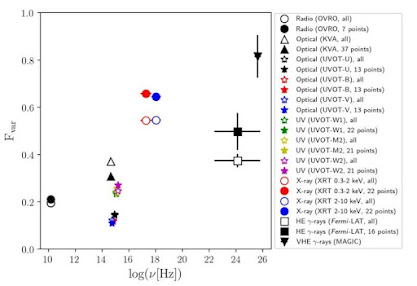Research inspects a distant gamma-ray emitting blazar
An international team of astronomers has performed a long-term multiwavelength study of a distant gamma-ray emitting blazar known as 1ES 0647+250. Results of the research, published November 23 on arXiv.org, yield important insights into the long-term variability of this source.
Listen this article in our podcast.
Blazars, classified as members of a larger group of active galaxies that host active galactic nuclei (AGN), are the most numerous extragalactic gamma-ray sources. Their characteristic features are relativistic jets pointed almost exactly toward the Earth. Based on their optical emission properties, astronomers divide blazars into two classes: flat-spectrum radio quasars (FSRQs) that feature prominent and broad optical emission lines, and BL Lacertae objects (BL Lacs), which do not.
At an estimated redshift of at least 0.29, 1ES 0647+250 is a BL Lac object reported to be a very high energy (VHE) gamma-ray emitter (above 100 GeV) with a flux of about 3% Crab Nebula flux units. The source is bright and variable in all the electromagnetic bands and has been observed many times in optical, radio and X-ray bands.
Previous observations of 1ES 0647+250 have detected significant variability in the optical band, but found no evidence of intra-night or short-burst variability. However, the variability timescales of 1ES 0647+250 in the optical band are still uncertain, mainly due to long gaps in the historical light curve.
Therefore, in order to shed more light on the variability of 1ES 0647+250, a group of astronomers led by Jorge Otero Santos of the University of La Laguna, Spain, has analyzed long-term multiwavelength data from various spacecraft and ground-based telescopes.
"In this paper, we perform the first long-term multiwavelength (MWL) study of 1ES 0647+250," the researchers wrote.
The study found that 1ES 0647+250 showcases significant long-term variability, especially in X-rays and VHE gamma-rays, with an increasing flux in radio, optical, and gamma-ray wavelengths. It was noted that such behavior is seen in other blazars, where the flux increase over year timescales is compatible with that expected from variations in the conditions of the accretion disk.
The data indicate a long-term correlation with no delay between the optical and gamma-ray emission. The radio emission is correlated with the optical and the gamma-ray bands with time lags of 393 and 398 days, respectively. According to the researchers, this delay suggests that the radio emission is being emitted from a distinct region of the blazar's jet, at a distance of about 11.73 light years.
X-ray spectra of 1ES 0647+250 show a harder-when-brighter behavior during the low state as well as for the flare that occurred in 2019. Moreover, the comparison of the simultaneous GeV and TeV spectra of the source during a flaring activity, allowed the astronomers to estimate its redshift, which was found to be 0.45.
The authors of the paper also analyzed the spectral energy distribution (SED) and found that it can be described reasonably well with the both one-component and two-component leptonic scenarios.
For more such news & interesting articles or how can it affect in your life subscribe to our newsletter



Comments
Post a Comment